This kung pao chicken recipe is all about big flavor, with the perfect balance of spice, crunch, and that glossy kung pao sauce. It’s quick enough for a weeknight and tasty enough to make your family think you pulled off something fancy.
And you’ll have it on the table in about 30 minutes, no takeout menu needed!
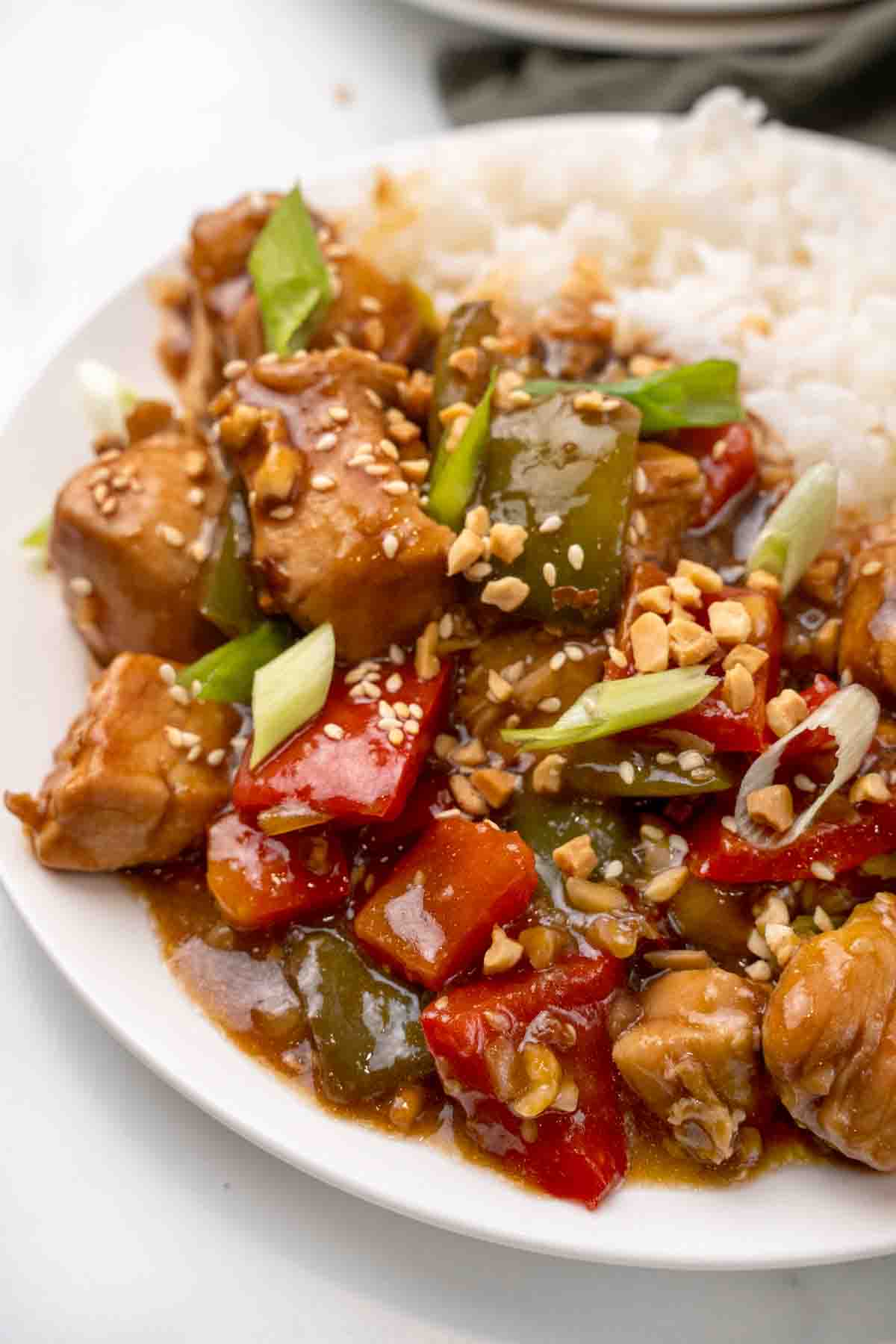
I still remember the first time I ordered Kung Pao Chicken at a little Chinese spot in Philly. One bite in and I was hooked, and I kept going back again and again.
Kung Pao Chicken started in Sichuan province, named after Ding Baozhen, a Qing Dynasty governor who clearly had very good taste in chicken. Over the years, it grew famous for its fiery dried chilies, crunchy peanuts, and that glossy sauce that hits sweet, savory, and just a little tangy.
Our Kung Pao Chicken brings all of that to your own kitchen, and it just might give your local Chinese restaurant a run for its money!

Most of the ingredients for this Kung Pao Chicken are pantry staples, and the few specialty items have easy swaps.
And it reheats like a dream, so don’t be surprised if tomorrow’s lunch tastes even better than dinner.
Round out the meal with our Chinese Sticky Chicken Wings to start, and don’t forget the fried rice. Our Pork Fried Rice and Shrimp and Chicken Fried Rice recipes are easy to tweak so they fit right in with this dish.
And for another Chinese takeout favorite, our General Tso’s Chicken is a verified crowd-pleaser you’ll want on the table.
Table of Contents:
View more
Ingredients
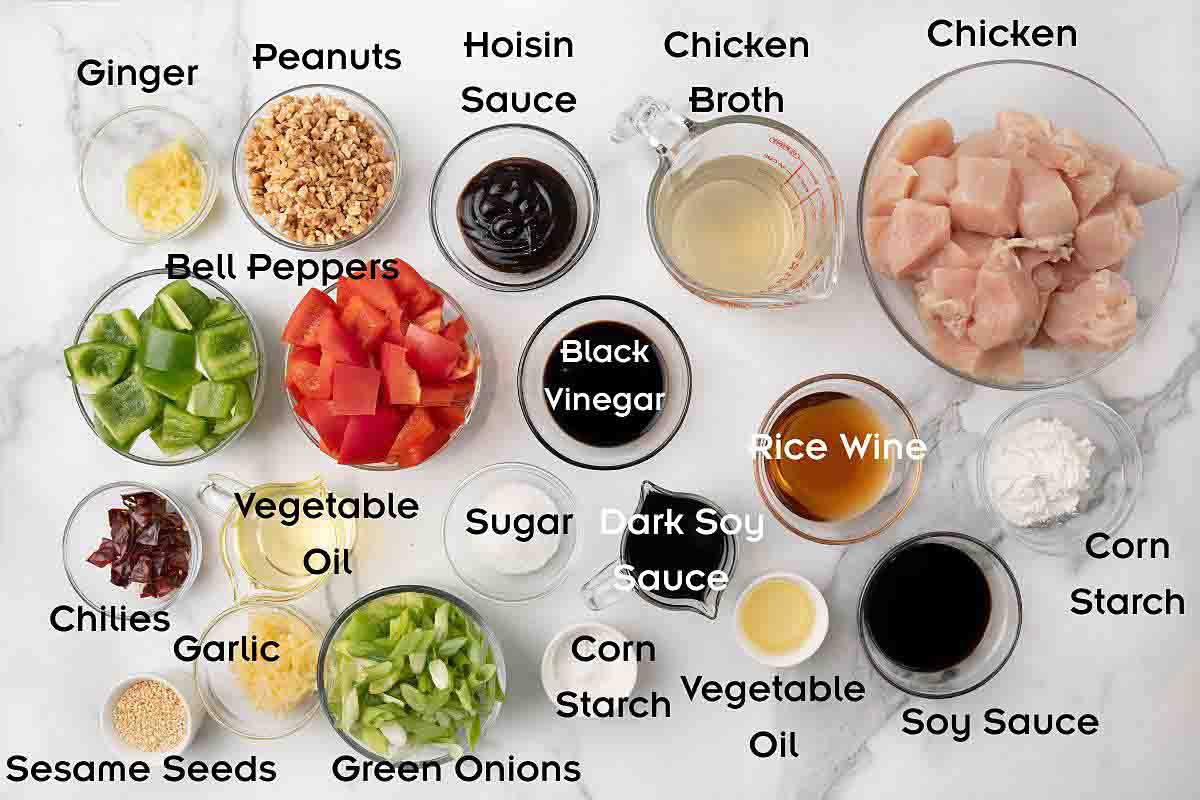
Gather the ingredients to prepare our Kung Pao Chicken recipe. Culinary professionals call this the “Mise en Place,” which means “everything in its Place.”
Setting up your ingredients not only helps speed up the cooking process but also ensures you have all the necessary ingredients on hand to make the recipe.
What are Shaoxing Wine and Chinese Black Vinegar?
Shaoxing wine is a Chinese rice wine that adds depth, aroma, and a touch of sweetness to stir-fries and sauces. Chinese black vinegar, or Chinkiang vinegar, brings a malty, smoky tang that makes dishes like Kung Pao Chicken shine. You’ll find both at Asian markets or online.
Dry sherry is the best substitute for Shaoxing wine if you have it on hand. For a non-alcoholic option, use chicken broth with a splash of rice vinegar. It won’t be quite the same, but it keeps the sauce balanced.
For black vinegar, balsamic is the easiest swap. It gives that dark tang, though a bit sweeter. Rice vinegar or white vinegar works in a pinch, but tastes lighter and sharper.
Both Shaoxing wine and black vinegar are worth grabbing if you see them. They add authentic flavor to marinades, braises, dipping sauces, and plenty of other Chinese recipes you’ll want to make next. Trust me, these bottles won’t collect dust once they’re in your pantry!
How to Make Kung Pao Chicken
Follow along with my simple step-by-step instructions to learn how to make Kung Pao Chicken in your home kitchen.
Cut the chicken into bite-sized pieces (¾ – 1 inch).
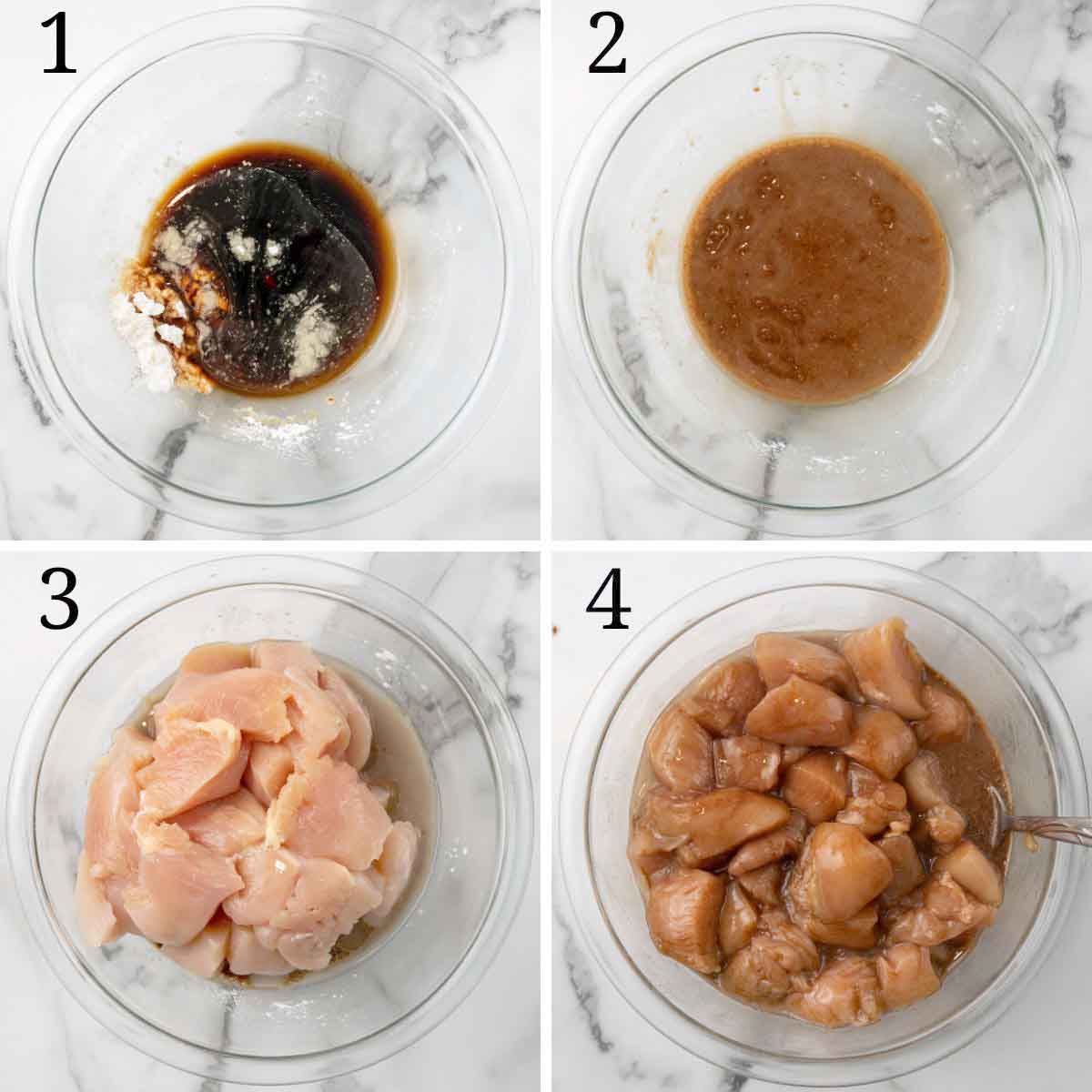
Add the soy sauce, cornstarch, Chinese Shaoxing wine, and vegetable oil to a large bowl.
Whisk to combine.
Add the chicken pieces to the marinade.
Let them sit in the marinade for 10- 30 minutes.
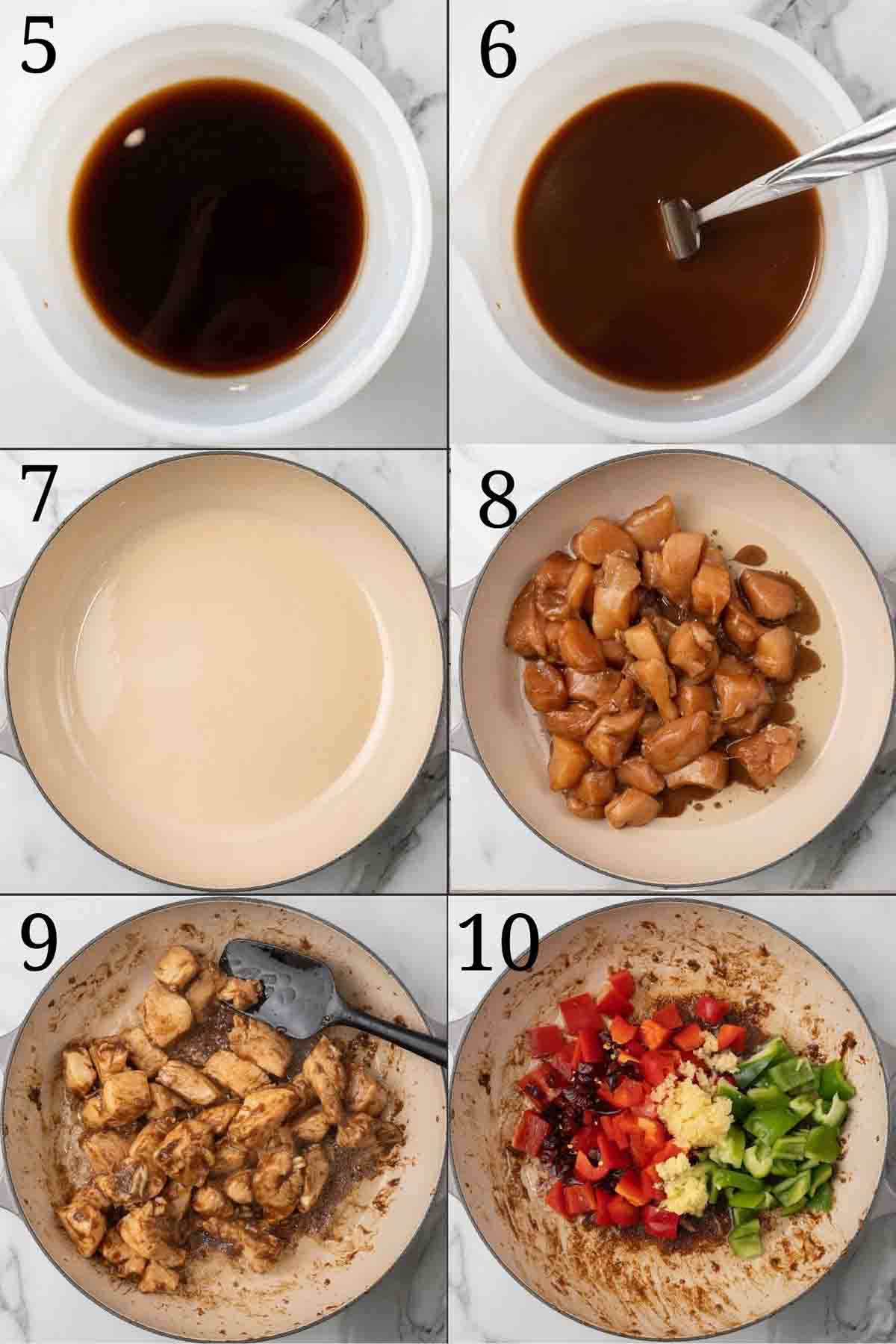
In another bowl, add the dark soy sauce, Chinese Shaoxing wine, hoisin sauce, chicken broth, granulated sugar, and corn starch.
Whisk to combine, and the cornstarch has been fully integrated.
Place a large skillet or wok over medium-high heat. When the pan is hot, add two tablespoons of the oil.
Add chicken to the pan.
Cook until it’s golden brown and almost fully cooked. Use a slotted spoon to remove it from the pan and set aside until needed.
Add the remainder of the oil to the same pan, then add chopped bell peppers, pressed garlic, grated ginger, and dried chilies.
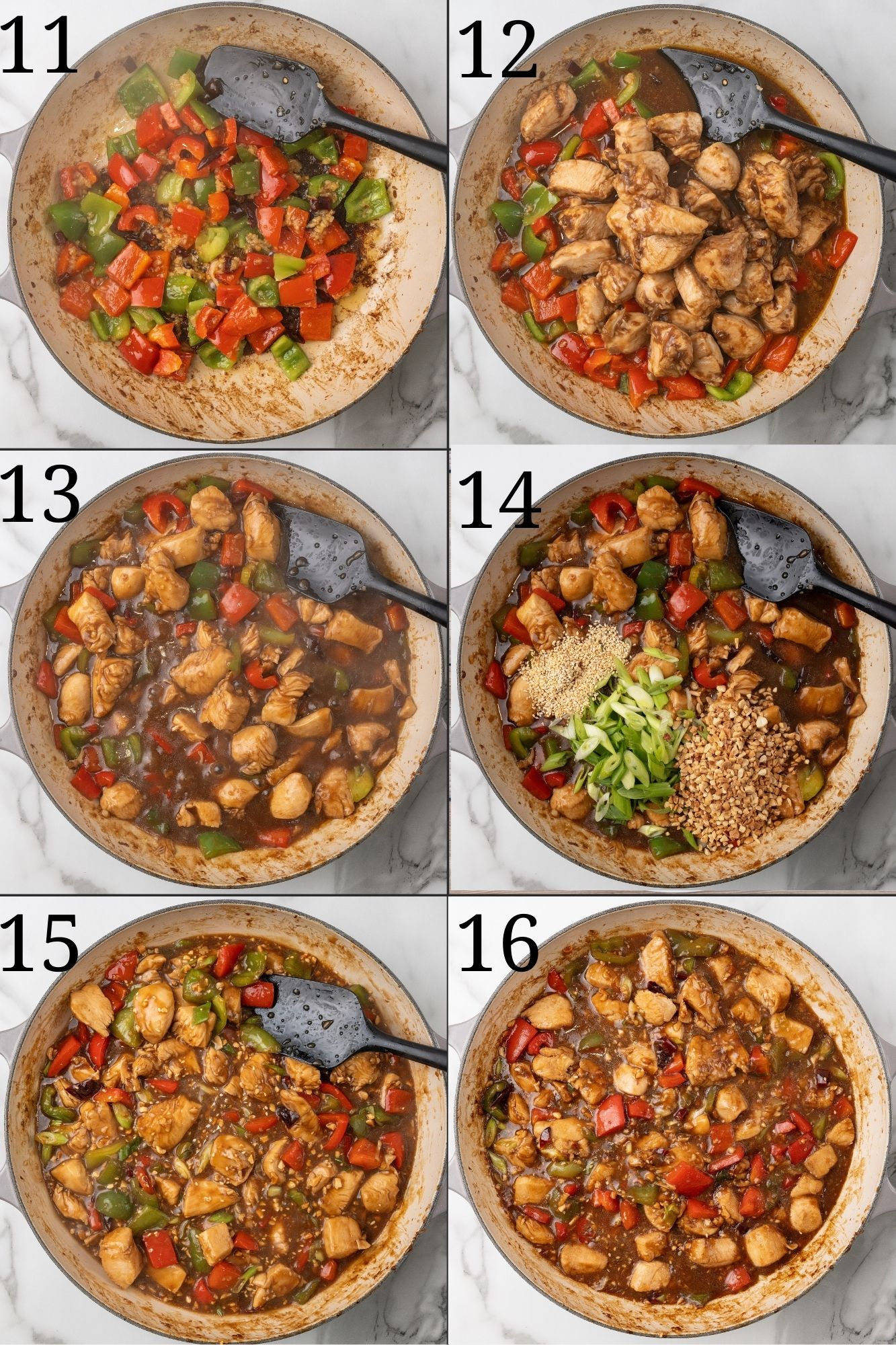
Stir fry for 3-4 minutes.
Whisk the kung pao sauce to make sure the corn starch hasn’t settled, then add it and the chicken to the pan with the vegetables.
Toss to coat the chicken with the sauce.
Add chopped green onion, peanuts, and sesame seeds to the pan.
Stir to combine. Reserve some of the green onions, peanuts, and sesame seeds to use as a garnish.
Stir to combine.
Simmer for 1-2 minutes until hot.
Chef Tips
For a change of pace, you can also make this dish with shrimp (don’t cook them too long), beef, pork, or tofu.
If you have time, toast the peanuts before using; it will intensify the flavor.
Don’t skip marinating the chicken; it adds flavor and gives it a tender, silky texture.
Adding sugar helps to balance out the heat and tanginess of the vinegar.
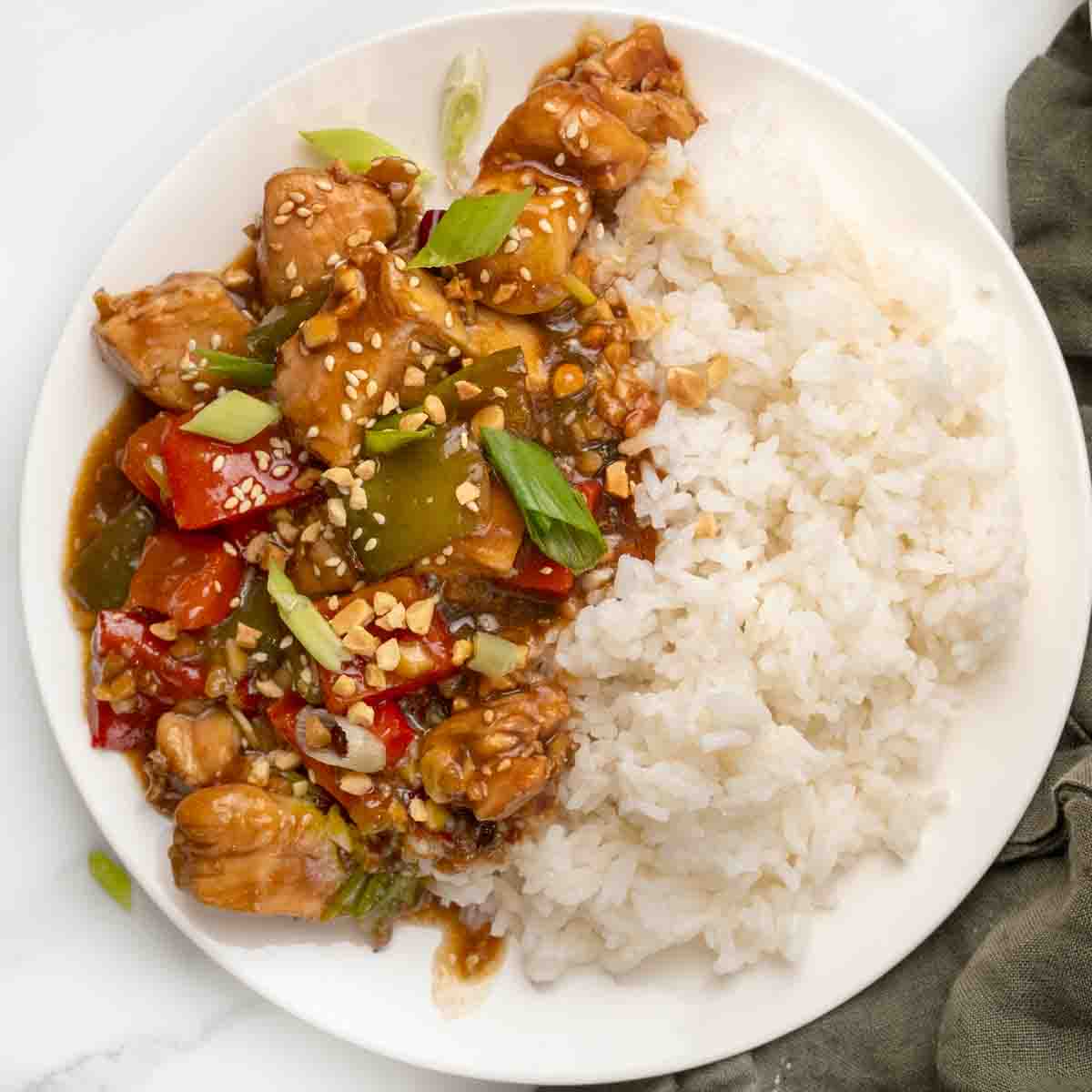
Our easy Kung Pao Chicken recipe is a crowd-pleaser for parties, game nights, or even New Year’s Eve when Chinese food is practically tradition.
Once everyone’s had a taste, it’ll take more than luck and good fortune to snag any seconds!
How to Store and Reheat
Leftover Kung Pao Chicken will keep in an airtight container in the fridge for up to 3 days.
Reheat gently in a skillet over medium heat until warmed through, or microwave in short bursts, stirring in between.
This dish isn’t ideal for freezing since the veggies lose their crispness and the sauce changes texture.
Recipe FAQs
It usually comes down to not letting the flavors build. Make sure you marinate the chicken, cook it hot and fast, and let the sauce reduce so it clings to every bite. That little balance of soy, vinegar, and sugar is what makes it pop.
If you toss them in whole, they’ll flavor the dish without too much heat. Cut them open and you’ll really feel the burn. Shake out some seeds if you want a milder kick, and remember, the chilies are mostly there for flavor, not for eating.
Both work great. Breast is classic and lean, but thighs are more forgiving and stay juicy. Use whatever you like best, just don’t overcook the pieces.
Absolutely. Cashews or almonds are a tasty stand-in, or you can leave the nuts out altogether and add more crunchy veggies. Don’t be afraid to adapt it to your tastes or dietary needs.
More Recipes You’ll Love!
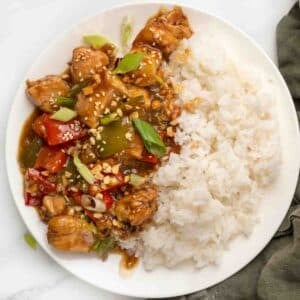
Authentic Kung Pao Chicken (Better Than Takeout)
Make Kung Pao Chicken at home with tender chicken, peanuts, and veggies in a spicy, tangy sauce. Better than takeout in just 30 minutes!
Ingredients
1x2x3x
Marinade
24 oz boneless skinless chicken breast cut into bite-sized pieces 2 tablespoon cornstarch4 tablespoon low sodium soy sauce or regular2 tablespoon Chinese Shaoxing wine rice wine2 teaspoon vegetable oil
Kung Pao Sauce
¼ cup dark soy sauce½ cup chicken broth2 tablespoon Chinese black vinegar or balsamic vinegar2 tablespoon Chinese Shaoxing wine rice wine1 tablespoon hoisin sauce1 tablespoon granulated sugar1 teaspoon cornstarch
Stir Fry
4 tablespoon vegetable oil for frying6 Chinese dried red chili peppers chopped roughly1 cup green bell pepper cut into ¾ inch pieces1 cup red bell pepper cut into ¾ inch pieces1 tablespoon fresh ginger grated4 large garlic cloves pressed about 2 tbsp6 green onions sliced on bias½ cup roasted peanuts1 teaspoon toasted sesame seeds
Instructions
Cut the chicken into bite-size pieces (¾ – 1 inch).
Add the soy sauce, cornstarch, Chinese Shaoxing wine, and vegetable oil to a large bowl. Whisk to combine.
Add the chicken pieces to the marinade and let it sit for 10- 30 minutes..
In another bowl, add the dark soy sauce, Chinese Shaoxing wine, hoisin sauce, chicken broth, granulated sugar, and corn starch. Whisk to combine, and the cornstarch has been fully integrated.
Place a large skillet or wok over medium-high heat. When the pan is hot, add two tablespoons of the oil.
Add chicken and cook until it’s golden brown and almost fully cooked. Use a slotted spoon to remove it from the pan and set aside until needed.
Add the remainder of the oil to the same pan, then add chopped bell peppers, pressed garlic, grated ginger, and dried chilies. Stir fry for 3-4 minutes.
Whisk the kung pao sauce to make sure the corn starch hasn’t settled, then add it to the pan with the vegetables.
Add the chicken to the pan. Toss to coat the chicken with the sauce.
Simmer for 1-2 minutes until hot.
Serve with white rice,
Notes
For a change of pace, you can also make this dish with shrimp (don’t cook them too long), beef, pork, or tofu.
If you have time, toast the peanuts before using; it will intensify the flavor.
Don’t skip marinating the chicken; it adds flavor and gives it a tender, silky texture.
Adding sugar helps to balance out the heat and tanginess of the vinegar.
How to Store and Reheat
Leftover Kung Pao Chicken will keep in an airtight container in the fridge for up to 3 days.
Reheat gently in a skillet over medium heat until warmed through, or microwave in short bursts, stirring in between.
This dish isn’t ideal for freezing since the veggies lose their crispness and the sauce changes texture.
Why does homemade Kung Pao Chicken sometimes taste bland?
It usually comes down to not letting the flavors build. Make sure you marinate the chicken, cook it hot and fast, and let the sauce reduce so it clings to every bite. That little balance of soy, vinegar, and sugar is what makes it pop.
How can I control the spiciness of dried red chilies?
If you toss them in whole, they’ll flavor the dish without too much heat. Cut them open and you’ll really feel the burn. Shake out some seeds if you want a milder kick, and remember, the chilies are mostly there for flavor, not for eating. You can also leave the chilies out if you prefer.
Can I make Kung Pao Chicken without peanuts?
Absolutely. Swap peanuts for cashews, almonds, or even sunflower seeds if you need a nut-free version.
What vegetables go best with Kung Pao Chicken?
Bell peppers, zucchini, celery, carrots, and green onions are common. Feel free to toss in whatever crisp vegetables you have on hand.
Can I use chicken thighs instead of chicken breast?
Yes, chicken thighs are juicier and more forgiving. They work perfectly for this stir-fry.
Is Kung Pao Chicken gluten-free?
If you use tamari or a gluten-free soy sauce, it’s easy to make gluten-free. Just double-check any bottled sauces you add.
What are Shaoxing Wine and Chinese Black Vinegar?
Shaoxing wine is a Chinese rice wine that adds depth, aroma, and a touch of sweetness to stir-fries and sauces. Chinese black vinegar, or Chinkiang vinegar, brings a malty, smoky tang that makes dishes like Kung Pao Chicken shine. You’ll find both at Asian markets or online.
Dry sherry is the best substitute for Shaoxing wine if you have it on hand. For a non-alcoholic option, use chicken broth with a splash of rice vinegar. It won’t be quite the same, but it keeps the sauce balanced.
For black vinegar, balsamic is the easiest swap. It gives that dark tang, though a bit sweeter. Rice vinegar or white vinegar work in a pinch, but taste lighter and sharper.
Both Shaoxing wine and black vinegar are worth grabbing if you see them. They add authentic flavor to marinades, braises, dipping sauces, and plenty of other Chinese recipes you’ll want to make next. Trust me, these bottles won’t collect dust once they’re in your pantry!
Nutrition
Calories: 375kcalCarbohydrates: 15gProtein: 31gFat: 21gSaturated Fat: 3gPolyunsaturated Fat: 9gMonounsaturated Fat: 6gTrans Fat: 0.1gCholesterol: 73mgSodium: 1302mgPotassium: 742mgFiber: 3gSugar: 5gVitamin A: 1157IUVitamin C: 56mgCalcium: 56mgIron: 2mg




